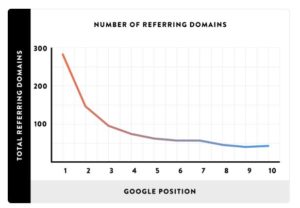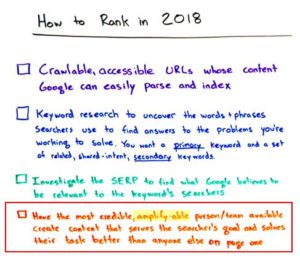Photo by Markus Spiske on Unsplash
Introduction
Organic search is an important referral source for many businesses, accounting for 94% of total organic traffic in 2017. Incorporating search engine optimization (SEO) into your digital marketing strategy is as important today as it was twenty years ago.
Back then, SEO experts focused on a few key ranking criteria such as backlinks, metadata and on-page optimization (e.g., keywords embedded in H1 tags and keyword-rich text).
Over the years, the process of SEO has grown and changed in response to many new factors which contribute to how Google ranks your website. Among these are: mobile friendliness, site speed, and secure domains (https), though there’s a lot more to achieving good rankings than this (massive understatement).
The minutiae of SEO is not for the faint of heart. This past May, Backlinko listed over 200 ranking factors divided into nine categories. Many businesses don’t have the time to devote to mastering every single factor. So, what’s really important?
We aim to answer that question In this post. We’ll review the importance of backlinks in modern SEO and a few other factors that you should focus on in 2019. But, first thing’s first…
Do backlinks still matter?
The short answer is yes, Backlinks remain a crucial factor for organic search ranking. According to Brian Dean of Backlinko, the number of referring domains is one of Google’s most important ranking factors.

Image Source: Backlinko
As you can see from the above chart, the highest Google positions directly correlate with having more referring domains.
Brian’s not alone in his assessment of the importance of backlinks. In December 2017, Rand Fishkin – a longtime search industry luminary – published a “How to Rank” checklist for 2018.
The focus of Rand’s checklist was on creating meaningful and high-quality content that is amplifiable (meaning, people will want to share it and link to it). Amplifiable content is content, according to Rand, helps with link building and social sharing because it’s created by someone who is credible and “worthy of amplification” – your CEO, for example.
Image Source: Moz
Thanks, Rand, for reminding us that we may not be worthy of amplification. But we digress…
If you’re not convinced that backlinks are important yet, a third authority on SEO, SEMRush, published a 55 page study that lists backlink factors as the fifth most important ranking criteria.
Backlink factors to consider for SEO
While the total number of referring domains plays a big role in Google’s ranking algorithm, there are additional factors to consider with backlinks as listed in the SEMRush study. They include the following:
- Total referring domains – This is self-explanatory. The more high-quality domains that link to your website, the better (as evidenced by the chart above).
- Total backlinks – This differs from total referring domains because a website might have multiple backlinks from the same domain, so the number of backlinks matter (even if they’re from the same domain). How many is a lot? For popular keywords, top-ranking websites had as many as 3000 total backlinks.
- Total referring IPs – The number of referring IPs Is important, though not as important as total referring domains. The top-ranking websites had between 20,000 and 25,000 referring IPs. For keywords that are less popular (e.g., lower search volume), the number of referring IPs doesn’t seem to be as critical.
- Total follow backlinks – Total follow links count towards your Google ranking factor – the more of these kinds of links, the better. There are links that don’t count called “No Follow” links which are qualified by a snippet of HTML code in the link tag. These links look like this:
<a href=”http://www.ashworthcreative..com/” rel=”nofollow”>Link Text</a>
- Total number of anchors – Website anchor tags are invisible positioning markers that direct users to specific sections of your site. The SEMRush study clarifies that anchor tags seem to hold more ranking weight for more popular keywords. You might use anchors (for example), if a webpage is very long and you want users to be able to navigate to certain sections of the page instantly. Here’s an example of an anchor tag which is embedded in a link – notice the anchor text is preceded by a hashtag:
<a href=”#more info”>More Info</a>
- Presence of keyword in the anchor – While including the targeted keyword in the anchor tag is a good best practice, it has the least influence on domain rankings except with very popular keywords.
Old-time SEO still reigns
So now that you know more than you ever wanted to about backlinks, what else should you consider when trying to rank at the top of Google’s search results in 2019?
Good old-fashioned relevant content still rules when it comes to ranking. High quality content, particularly long-form content, tends to garner inbound links. It also keeps people on your website longer which is a ranking factor for Google. The assumption is that when visitors don’t bounce away from your content, it must be relevant and is therefore worthy of a higher search engine position.
Keyword-rich content is another important ranking factor, but it’s important to consider two things – 1) Google hates keyword stuffing, so write with natural language and 2) make sure your content really speaks to what people are searching for. Rand Fishkin touched on this with his “How to Rank” checklist noting that website owners should do keyword research to help discover words and phrases that searchers use – and keep in mind that more people are asking questions either via voice search or typing them directly into Google.
Metatags still matter, so pay attention to the title tags of your webpages (this is what appears as the clickable link on the search results pages) and meta description which is the snippet of text directly beneath the title. One of Google’s top ranking factors is still CTR, so a compelling link title is really imperative.
Make sure you include H1 and H2 tags in your webpages (wow, that’s REALLY old school) because pages using at least one H1 or H2 heading tend to rank better.
Modern SEO ranking factors to consider
The modern search marketer has her work cut out for her. In addition to the tried and true (old fashioned) ranking factors listed above, there are many new factors to consider. Here’s a short list.
- Make sure your website is mobile friendly since Google’s index will crawl the mobile version of a website first before the desktop version. Your website should be responsive on all mobile platforms – this is now the rule rather than the exception.
- Make sure your website is fast. Mobile sites should load in 2 seconds, while desktop sites should load in 3. The top-ranked websites are the ones that load the fastest.
- Make sure your website is encrypted – that is, it uses HTTPS encryption since nearly 50% of top-ranking websites all use HTTPS, up from 12% in 2015!
Happy optimizing in 2019
At the beginning of this post, we set out to answer the question, “do backlinks matter?” This lead to some fascinating insights which we hope you’ll find useful when planning your 2019 SEO strategy.
It’s extremely interesting (and possibly comforting) that many ranking factors have stayed the same since the early days of SEO. Content is at the center of a good SEO strategy, just as it was twenty years ago. On-page optimization, meta tags, and backlinks are all key criteria in Google’s ranking algorithm (as they were in the old days).
Implementing these factors alongside newer factors such as mobile-readiness, site encryption and fast-loading pages, will help you rank higher in the coming year.



Nice Article..
Do no follow backlinks also consider a ranking factor?
Awesome article, Thanks for sharing!
I’m implementing much of this now, especially getting more backlinks and referring domains but it is really time consuming!